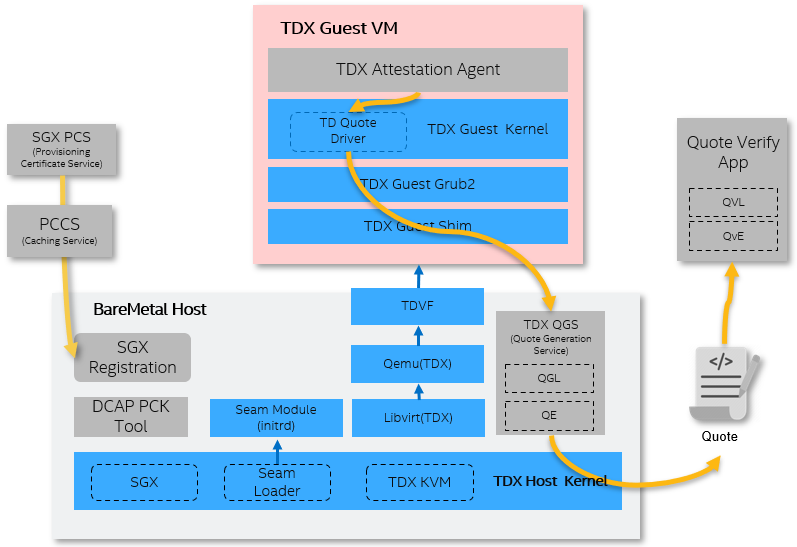Intel® Trust Domain Extensions(TDX) refers to an Intel technology that extends Virtual Machine Extensions(VMX) and Multi-Key Total Memory Encryption(MK-TME) with a new kind of virtual machine guest called a Trust Domain(TD). A TD runs in a CPU mode that protects the confidentiality of its memory contents and its CPU state from any other software, including the hosting Virtual Machine Monitor (VMM). Please get more details from TDX White Papers and Specifications
This repository helps to:
- Build individual component's package or install pre-build binaries on IaaS host or create PaaS guest image for quick evaluation
- Generate the patchsets for deep dive in source code level
- Test, hack and debug the TDX technology based on pycloudstack framework
- Dump guest VM measurement and generate TD quote report for TDX E2E attestation
- Measured boot and Secure boot for TDX guest VM
NOTE: The main branch is for TDX SW stack usage with kernel 5.19. Please switch to branch mvp-tdx-5.15 for TDX SW stack usage with kernel 5.15.
Intel® TDX(Trust Domain Extensions) MVP Stack includes the components in below diagram:
| Name | Stack | Description |
|---|---|---|
| TDX Kernel | Host + Guest | Linux kernel for TDX |
| TDX Qemu-KVM | Host | Qemu VMM for TDX |
| TDX SEAM Module | Host | TDX Secure Arbitration Module |
| TDX Libvirt | Host | The modified libvirt to create TDX guest domain via Qemu |
| TDVF | Host | The modified OVMF(Open Source Virtual Firmware) to support TDX guest boot like page accept, TDX measurement |
| TDX Grub2 | Guest | The modified grub for guest VM to support TDX measurement |
| TDX shim | Guest | The modified shim for guest VM to support TDX measurement |
To build all components, run the following commands:
cd build/rhel-8
./build-repo.sh
NOTE: Please refer detail instructions for different distros in build
directory.
This will build all packages and create two repositories, one for guest and one for host.
Move the host repo to a known location:
sudo mkdir -p /srv/
sudo mv repo/host /srv/tdx-host
To use the repo, create the following file as /etc/yum.repos.d/tdx-host-local.repo:
[tdx-host-local]
name=tdx-host-local
baseurl=file:///srv/tdx-host
enabled=1
gpgcheck=0
module_hotfixes=true
Finally, install packages as follows:
sudo dnf install intel-mvp-tdx-kernel intel-mvp-ovmf intel-mvp-tdx-qemu-kvm intel-mvp-tdx-libvirt
NOTE: Please get separated RPM for signed build TDX SEAM Module and install via
sudo dnf install intel-mvp-tdx-module. After installation, please reboot
machine with tdx_host=on numa_balancing=disable in host kernel command via grub menu. Finally, please
verify TDX host.
After building TDX components packages please refer to Setup TDX Guest Image to install
them into a cloud image. It uses RHEL 8.6 as an example distro.
You can start-qemu.sh to create TD guest quickly as below. Please get detail grub/direct boot template for qemu-kvm and libvirt at Launch TD Guest.
- Launch a TDX guest via direct boot
./start-qemu.sh -i td-guest-rhel-8.6.qcow2 -k vmlinuz-rhel-8.6
- Launch a TDX guest via grub boot
./start-qemu.sh -i td-guest-rhel-8.6.qcow2 -b grub
- Launch a debug version TDX guest with debug version OVMF
./start-qemu.sh -i td-guest-rhel-8.6.qcow2 -k vmlinuz-rhel-8.6 -d
- Launch a non-TDX guest
./start-qemu.sh -i td-guest-rhel-8.6.qcow2 -k vmlinuz-rhel-8.6 -t efi
After TDX guest image is created, please refer to TDX Tests to run tests. It uses
RHEL 8.6 as example distro.
